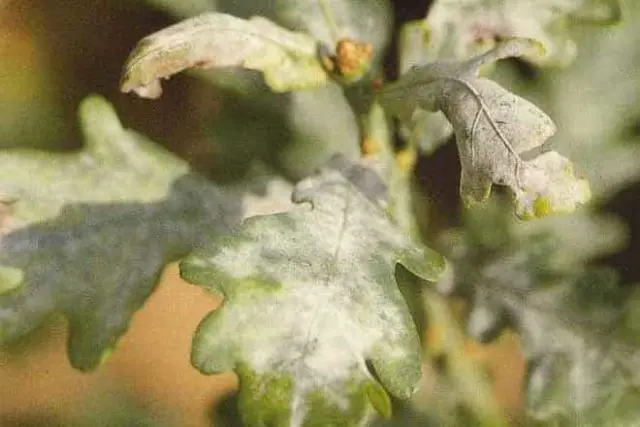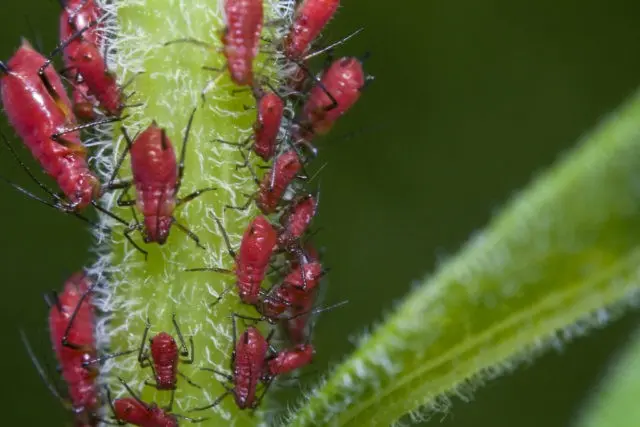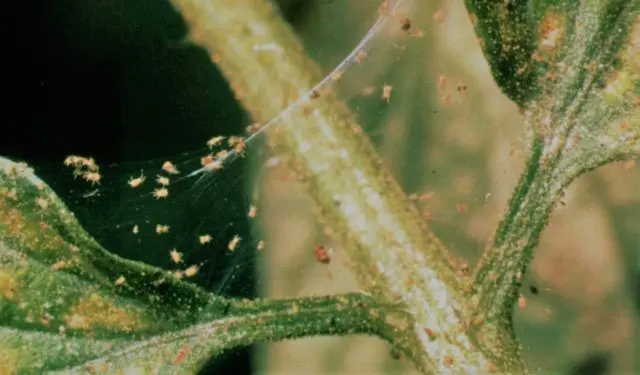Contents
- Description of chrysanthemum indicum
- Varieties of Indian chrysanthemum and their description
- Ways to grow Indian chrysanthemum
- Planting and caring for terry chrysanthemum indicum
- Reproduction of Indian chrysanthemums
- Diseases and pests of Indian chrysanthemums
- Photo of Indian chrysanthemums
- Conclusion
- Reviews of Indian chrysanthemums
Thanks to the huge number of shapes, sizes and colors, chrysanthemums are very widespread in various parts of the world. High decorativeness, combined with ease of care, make them one of the most sought-after garden flowers, while breeding work to develop new species does not stop. One of the varieties of this perennial is the Indian chrysanthemum, which, unlike its Korean relative, is grown mainly in greenhouse conditions.
Description of chrysanthemum indicum
In the wild form, the Indian chrysanthemum was previously found on the territory of modern China, in areas with a subtropical climate. All varieties of this plant have retained its species characteristics.
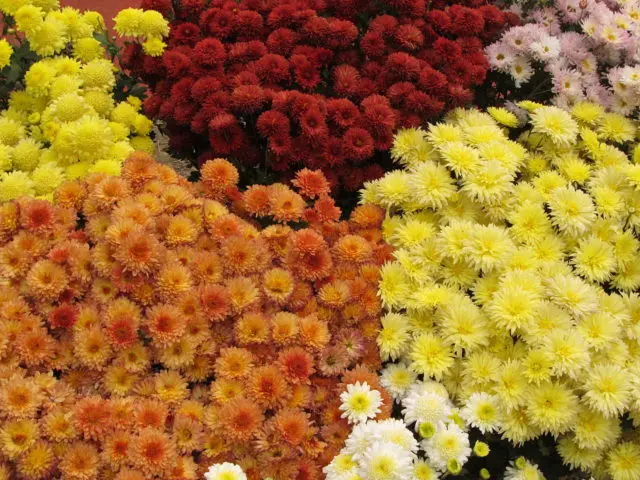
The Indian species has many varieties and colors.
Here is a brief description of the Indian chrysanthemum:
Parameter | Value |
Type of plant | Perennial herbaceous, Aster family (Asteraceae). |
Shoots | Smooth, straight, green, 0,3-1,5 m high, depending on the variety. |
Leaves | Strongly dissected, serrated. The leaf plate is greenish-gray, dense, fleecy. |
Root system | Powerful, well developed, form a large lobe. |
Flowers | Inflorescence-basket of chamomile type, consisting of a central part with tubular flowers and bordering flat petals of various colors and shades. The size of the inflorescences depends on the variety and can reach up to 25 cm in diameter. |
Fruit | Small oblong ribbed brown achenes. |
Flowering time | Autumn. |
Varieties of Indian chrysanthemum and their description
There are more than 10 thousand varieties of Indian chrysanthemums. Among them there are plants both with large, 20-25 cm in diameter, inflorescences, and with small, “button” ones, there are species for open ground and for growing indoors.
Aurora
This variety of Indian chrysanthemum forms a bush about 1 m high, blooms with very beautiful orange flowers. Inflorescences are terry, flat, with a diameter of 7 to 10 cm.
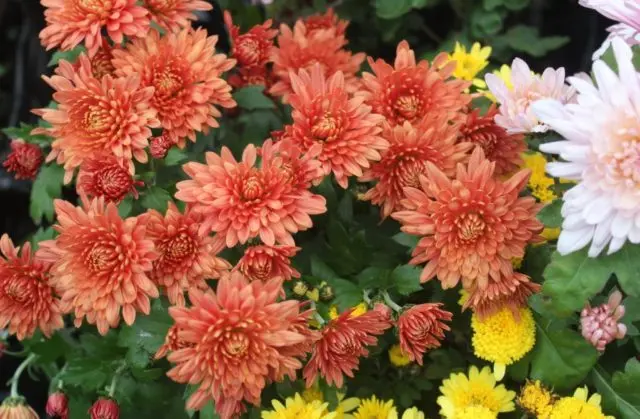
Bright orange inflorescences of Aurora look especially beautiful in autumn.
Altgold
The bushes of this variety of Indian chrysanthemums are low, up to 0,6 m. The inflorescences are flat, saturated yellow, up to 7 cm in diameter. The variety blooms early, the first buds appear on the bushes in the second half of August. Flowering continues until October.
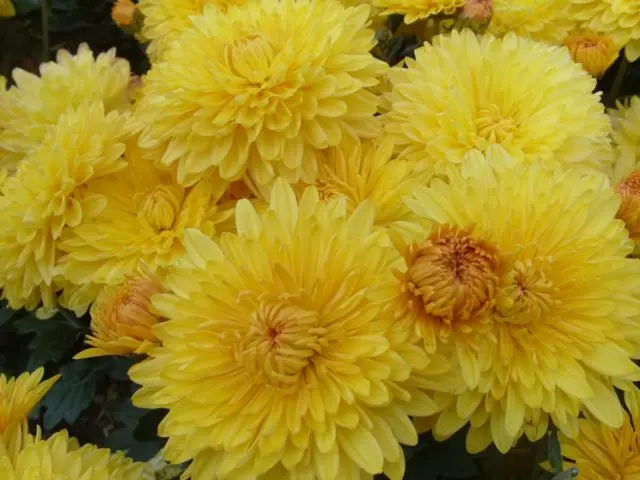
Altgold blooms earlier than others, in mid-August
Artist
This is a potted variety of chrysanthemums, growing in a small compact bush with a height of no more than 0,3 m. Its distinguishing feature is the two-tone color of the petals in the form of longitudinal stripes.
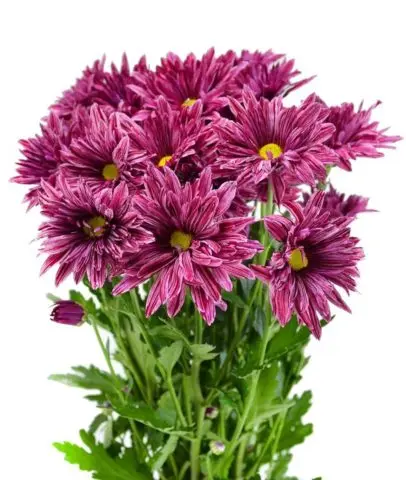
Two-tone coloring in the form of longitudinal stripes is the visiting card of the Artist
There are also varieties of chrysanthemum Indian Artist with yellow-brown and orange-red flowers.
Barolo
This variety of Indian chrysanthemums can be grown both in a pot and in open ground. Even, straight and rather powerful shoots of the plant form a dense bush about 0,5 m high. The flower basket consists of red petals surrounding a green-yellow core.
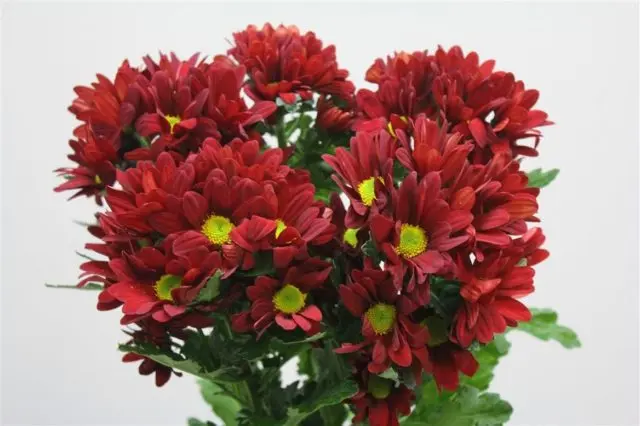
Indian Barolo can be grown as a pot
Cleopatra
This chrysanthemum has a very unusual color – terracotta. The petals are colored in such a way that the inflorescences look like they are lit by the bright sun. Cleopatra blooms for a very long time, from August to October, and in the absence of frosts, flowers can be admired in November.
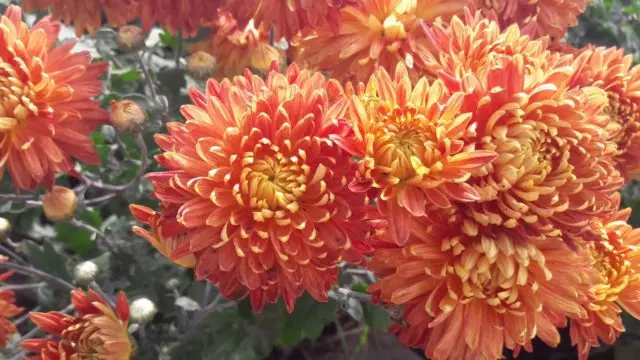
The Cleopatra variety has a long flowering
Like Worth
Like Worth chrysanthemums are not large, their bush height is only about 0,3 m. Simple chamomile-type inflorescences look very impressive because of the bright two-color petals surrounding the greenish-yellow middle.
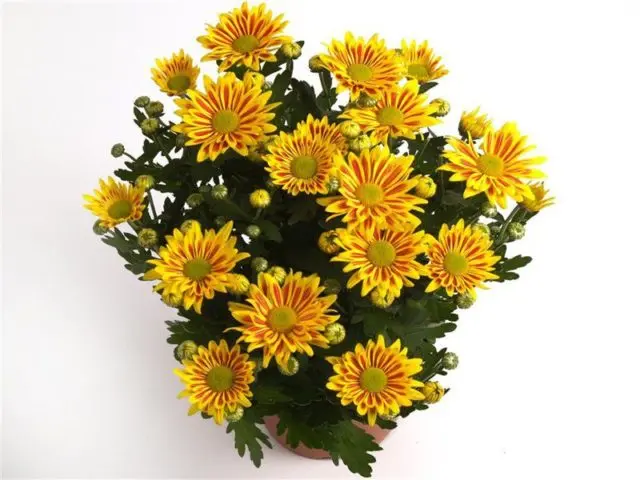
Light Worth – a potted view of Indian chrysanthemums
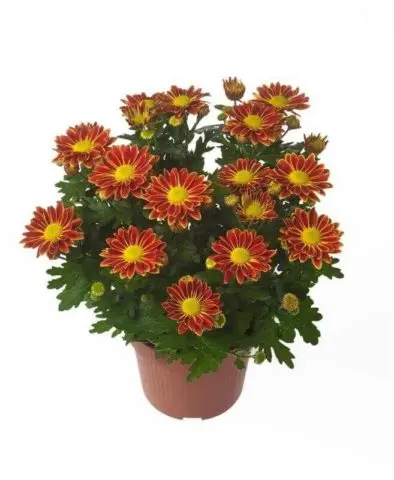
The variety also has a darker variety – Like Worth Dark
Little Rock
Little Rock is another representative of Indian chrysanthemums, most often grown indoors. The color of the petals is rich burgundy, with a white border. Little Rock bushes are very small – 25-35 cm.
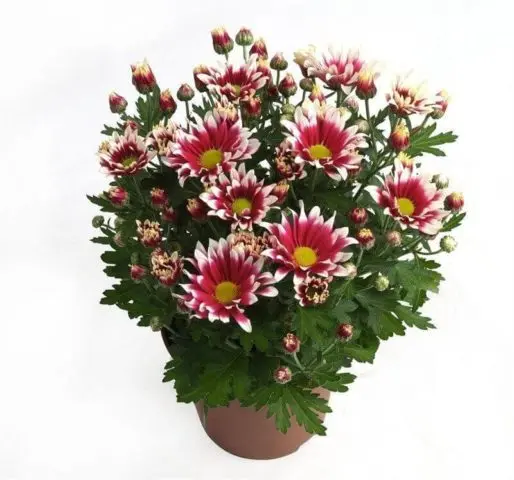
One of the smallest varieties – Little Rock
Pura Vida
Like many other varieties of Indian chrysanthemums, Pura Vida is most often grown in pots. The height of the bush does not exceed 0,25-0,3 m. The petals in the central part of the inflorescence are bright green, becoming lime color closer to the edge, the edging is white.
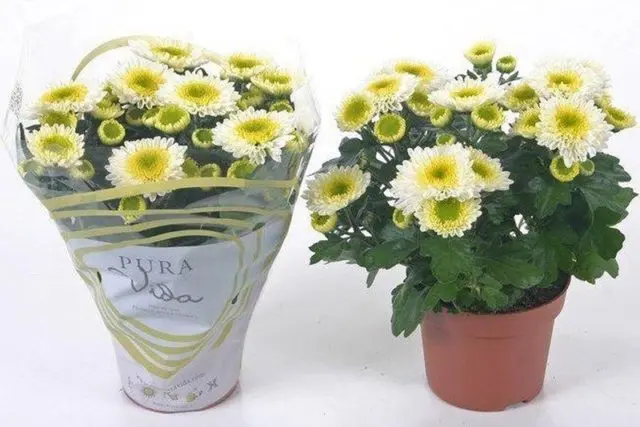
Pura Vida – a variety with an unusual yellow-green color of inflorescences
Ways to grow Indian chrysanthemum
Indian chrysanthemums can be grown both outdoors and as potted plants. Many varieties are small in size and may well grow as indoor flowers. Large-sized species in a suitable climate are grown in open ground, this can also be done in special rooms with an artificial microclimate – winter gardens, greenhouses.
Growing Indian chrysanthemum outdoors
Heat-loving Indian chrysanthemums are planted in open ground only with the onset of real heat, in order to completely eliminate the possibility of return frosts. After flowering, the shoots are cut off at a height of 15-20 cm from the ground, and the bushes are dug up, put into wooden boxes, sprinkled with sand and taken to the basement for the winter. There they are stored all winter without watering at a temperature of 0-2 ° C, and after the arrival of heat they are planted again in the garden.
Growing and caring for Indian chrysanthemum at home
Indoor Indian chrysanthemums tolerate the vagaries of the weather worse and require increased care. The height of potted species does not exceed 0,7 m, they do not take up much space. They bloom, as a rule, very late, in autumn, when many indoor plants are already in hibernation. Unlike many plants, indoor Indian chrysanthemums do not require elevated air temperature. On the contrary, for her it is necessary to ensure that this indicator is within 15 ° C, so it is best to place flower pots on windows facing north.
Planting and caring for terry chrysanthemum indicum
In the open ground, Indian chrysanthemum is taken out by seedlings, which can be purchased at a specialized store or grown independently using seed or vegetative methods.
Selection and preparation of the landing site
For chrysanthemums, you should choose an open sunny place, these plants do not like shade. The soil on the site should be loose, moderately moist, with good breathability. You should not plant chrysanthemums in swampy and flooded areas, it is better to give preference to a small hill. If the ground is too clayey, then sand or other drainage material should be added, and the area should be fertilized with humus or peat. The PH level should be close to neutral. Soil acidity can be reduced by adding dolomite flour or chalk.
Rules of landing
Planting Indian chrysanthemums is done in May, and sometimes it is done even in June, in order to ensure that return frosts are avoided. All work should be done in cloudy, wet weather, but if it is sunny and dry outside, then the landing is done in the late evening. If for some reason it was not possible to plant chrysanthemum seedlings in the spring, then this procedure can be carried out in early September. If the climatic features of the region do not allow plants to winter in open ground, then they should be rooted in pots, and after wintering they should be planted in a permanent place.

Planting chrysanthemums is carried out only after the soil warms up
Planting pits for Indian chrysanthemums should be at least 40 cm deep, since a drainage layer of coarse sand or small pebbles must be poured onto the bottom. It is better to mix the soil, which is to be covered with plant roots, with humus, in addition, you can add a little potash and phosphorus fertilizers to its composition. The seedling is placed vertically in the center of the pit and carefully covered with soil mixture without deepening the root neck. If the plant is tall, then for the first time it is better to tie it to a support from wind and rain.
Watering and top dressing
Water the Indian chrysanthemum moderately, excess moisture can lead to root rot. You need to navigate by the state of the soil layer in the root zone of the plant. Moisturizing should be carried out only as it dries, which is easily determined visually.
The standard watering rate is approximately 10 liters of water for each adult bush 1 time in 3 days. In wet weather, additional watering of chrysanthemums is not necessary. For irrigation, it is desirable to use rainwater. If the source is a water pipe, then before watering the water should be allowed to stand for at least 2 days.
Indian chrysanthemums need to be fed throughout the season. In the spring, fertilizers containing nitrogen are used for the rapid growth of shoots and the growth of green mass. In the middle of summer, nitrogen-containing top dressings cease to be applied. Further, only complex potassium-phosphorus fertilizers are used, which stimulate flowering and budding for the next year.
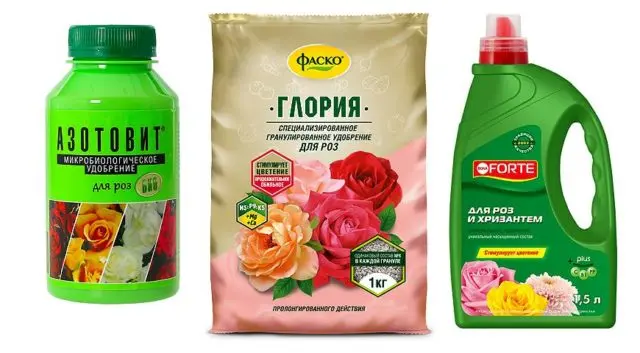
Long-acting fertilizers are much more effective than conventional fertilizers.
Wintering of Indian chrysanthemums
Indian chrysanthemums, even large-flowered ones, can be left for wintering in the open field, but only if the climatic features of the region allow this. In this case, the shoots are completely cut off just above the soil level, and then the bush is covered with a thick layer of fallen leaves, spruce branches, and later the shelters are covered with snow. Unfortunately, there are relatively few frost-resistant varieties of Indian chrysanthemums. Therefore, after the onset of the first frosts, the bushes are cut and dug up along with a clod of earth on the roots, taking them for wintering to a basement or other room with a suitable microclimate.
How to shape Indian chrysanthemums
To increase bushiness 2-3 times a season, pinch the top of the Indian chrysanthemum shoot. This stimulates the growth of side branches. The last pinching is done no later than 2 weeks before the first buds appear, otherwise the flowers simply will not have time to form.
Reproduction of Indian chrysanthemums
The most common method of propagation of Indian chrysanthemums is seed, sowing material begins to be planted around February. Before that, they must be subjected to stratification, withstanding for some time at a low temperature. This will significantly increase their germination and viability. For planting, you can adapt any container that is filled with purchased soil for seedlings or home-made soil mixture from top soil, peat and sand.

Calcining the soil for seedlings will help to avoid the development of diseases
A container for growing seedlings of Indian chrysanthemums from seeds must be filled with soil mixture almost to the top so that after closing it with glass or film, an air gap of 3-5 cm remains. Before planting, the soil must be moistened with warm water from a spray bottle. The seeds are poured in even rows, observing an interval of about 10 cm between the strips. You should not fill the seeds with soil, just lightly press them against the soil surface. After that, the container must be covered with a piece of glass or plastic wrap and put away in a warm, dark place until shoots appear.
The first shoots usually appear after 7-10 days. After that, the container with seedlings is transferred to the windowsill. If the daylight hours last less than 8 hours, then it is necessary to provide for the possibility of artificial additional illumination of seedlings by installing any light source from above. Very well suited for this purpose are special phytolamps, which give light of a certain color spectrum, which is most necessary for plants. At the end of spring, seedlings are planted in a permanent place in the garden or planted in pots.

Seed propagation method is simple and effective
Another way to propagate Indian chrysanthemums is cuttings. Cuttings about 20 cm long are cut from mature shoots and rooted in a container with soil mixture, covered with a film. In such greenhouse conditions, the cuttings quickly form their own root system, after which they are seated.
Diseases and pests of Indian chrysanthemums
Almost all diseases of Indian chrysanthemums are the result of improper care or an unsuitable climate for plants. Fungal infections are the most common, causing damage to the entire aerial part.
Here are some diseases found on chrysanthemums:
- White rust. Fungal disease, which can be recognized by the numerous light yellow round spots on the leaves. Over time, the spots turn brown, turning into pockets of rot. When signs of the disease appear, the infected parts of the plants are cut and burned, and the bushes themselves and neighboring plantings are treated with preparations containing copper (Bordeaux mixture, HOM).

Yellowish rust pads are clearly visible on a green leaf.
- Powdery mildew. This disease often develops in a cold rainy summer or with a sharp drop in temperature. Appears as a dirty white powdery coating on the leaves, which subsequently quickly turn black. Infected plants are destroyed, and neighboring ones are sprayed with a solution of soda ash with the addition of liquid soap.

A light coating on the leaves is a sign of infection with powdery mildew.
In addition to diseases, Indian chrysanthemums are often attacked by pests:
- Brown aphid. These small insects feed on young greens, often damaging flower buds as well. As a means of combating aphids, special preparations are used – insecticides, which are used to spray the bushes.

Brown aphid spoils the appearance of the plant and inhibits its growth
- Spider mite. It is a small garden pest found on many crops. Tick nests are easy to recognize by the web that entangles the tops of the shoots. When found, they must be cut and destroyed, and the bushes should be treated with acaricidal preparations.

Spider mite is easy to detect by the abundance of cobwebs on the shoots
Photo of Indian chrysanthemums
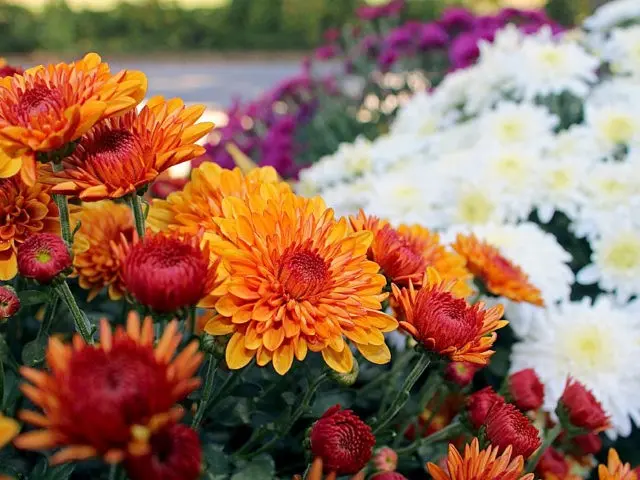
Indian chrysanthemums – real queens of autumn

Indian flowers are great in mixed plantings.
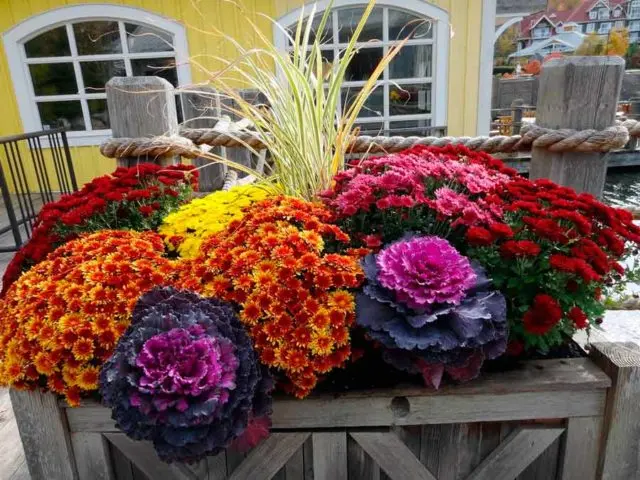
An impromptu high flower bed with chrysanthemums looks great as an element of garden decor
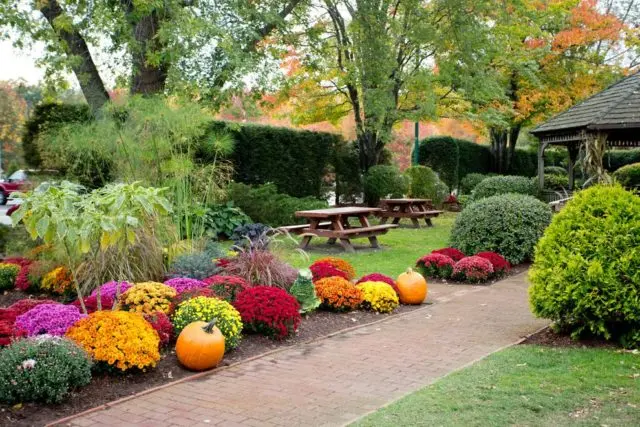
Blooming Indian chrysanthemums will add color to the garden in autumn

Pots with Indian chrysanthemums can be removed indoors for the winter
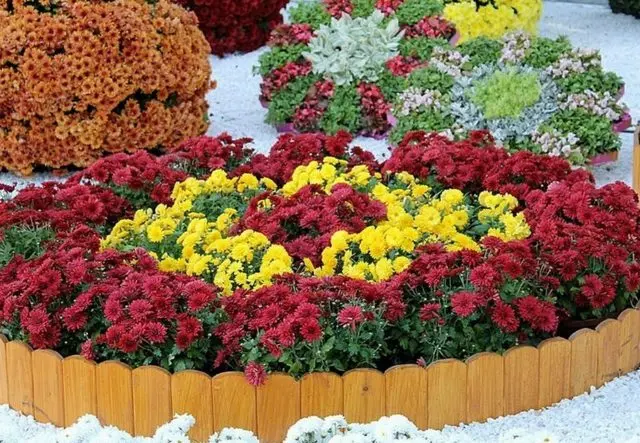
Indian chrysanthemums can be combined in flower beds in various patterns
Conclusion
Indian chrysanthemum is able to decorate not only the adjacent plot, greenhouse or winter garden, but also an ordinary apartment. Due to the abundance of low varieties of various colors, they can be grown as potted plants. Many gardeners do just that, cultivating chrysanthemums in containers and putting them on display in the garden during the warm season without transplanting into open ground.











